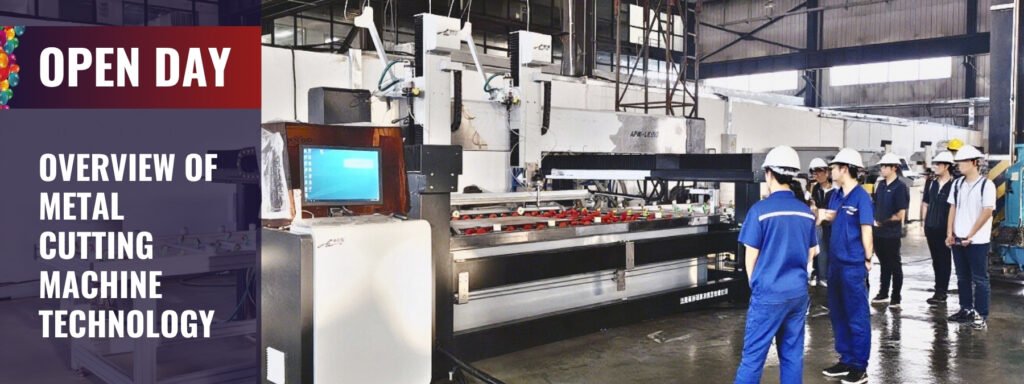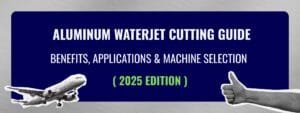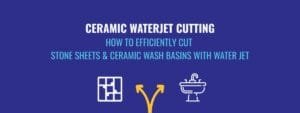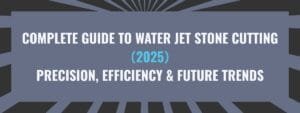In July 2025, leading Chinese waterjet manufacturer APW Waterjet hosted an Open Day at its Shenyang headquarters. The event welcomed representatives from universities, industrial manufacturers, and research institutions to explore the company’s latest achievements in metal cutting machine technology.

The showroom featured various high-precision waterjet systems, including 3-axis platforms, 5-axis intelligent cutting centers, and ultra-high-pressure pumps. Smart path simulation and live demonstrations attracted keen attention. As one APW engineer explained:
“Traditional thermal cutting methods can no longer meet the demand for high-precision, high-strength, and multi-material processing. High-pressure waterjet cutting, as a cold-cutting method, is now a core technology in next-generation metal cutting machines.”
Overview of Metal Cutting Machines Technology: A Comparative Guide
To help visitors gain a comprehensive understanding of cutting systems, APW engineers outlined the strengths and limitations of four major metal cutting technologies:
| Cutting Method | Principle | Advantages | Limitations |
| Mechanical Cutting | Physical contact with cutting tools | Low cost, mature process | Tool wear, difficult for complex geometry |
| Thermal Cutting | Melting metal with high temperature | Fast and efficient | Heat-affected zone, deformation risk |
| Electrochemical Cutting | Electric discharge or chemical etching | High precision, good for micro-features | Limited materials, low efficiency |
| Waterjet Cutting | High-pressure water + abrasive impact | Cold cut, versatile, no heat distortion | Higher initial equipment investment |
5-Axis Waterjet in Action: Mastering Complex Geometry
A manufacturing engineer from the aerospace industry noted:
“Conventional metal cutting machines struggle with angular and curved surfaces, requiring secondary reshaping after cutting.”
APW demonstrated how its proprietary 5-axis waterjet system enables dynamic A/C-axis rotation and spatial angle control, handling challenging parts like turbine blade contours and automotive exhaust ports in a single operation.
Key Capabilities:
- Z-axis lift + A/C dual rotation platform
- Adaptive toolpath generation
- Cutting accuracy within ±0.05 mm
- Real-time collision detection and path simulation
Ultra-High-Pressure Pump: The Heart of the Waterjet System
In the component display area, a maintenance engineer asked:
“How do these systems ensure sealing under such extreme pressure without leaks?”
APW’s team presented a disassembled pump module and explained:
- Ceramic plungers combined with custom sealing rings
- Operates stably at up to 600 MPa
- 20% longer service life than comparable imported models
- Modular design allows quick replacement and reduced downtime
This sealing solution has been successfully applied in heavy industry and railway equipment manufacturing environments.
Microstructure Comparison: Laser vs. Waterjet Edge Quality
A materials scientist inquired:
“Do you have micro-level evidence showing that waterjet cutting causes less damage than laser cutting?”
APW responded with microscopic images comparing sample edges:
- Laser-cut aluminum showed heat-affected burn marks and recrystallization
- Waterjet-cut edges remained clean, oxidation-free, and structurally intact
“Waterjet cutting physically separates material without introducing thermal stress, making it ideal for sensitive materials like carbon fiber, titanium alloys, and ceramics.”
Research-Oriented Topics: Waterjet in Academia and R&D
University faculty and graduate students engaged in discussions on the academic potential of waterjet research.
APW engineers recommended several promising research directions for thesis projects, R&D collaboration, and curriculum development:
- 5-axis toolpath optimization algorithms
- Cutting parameter database for composite materials
- Real-time abrasive flow monitoring systems
- Robotic-arm + waterjet hybrid workstations
- Predictive maintenance models for high-pressure pump systems
“Waterjet is a true interdisciplinary field, integrating fluid dynamics, materials science, automation, and precision engineering—ideal for collaborative university research.”
Going Global: APW Metal Cutting Machines in 60+ Countries
At the “Global Client Wall,” visitors learned that:
- APW exports to over 60 countries
- Applications include aerospace, automotive, energy, and architectural materials
- Complete solutions include hardware, control software, and industrial integration
- Multi-language interfaces and international certifications available
“A metal cutting machine today is more than a tool—it’s a convergence of algorithms, mechanical systems, and intelligent controls. APW is proud to bring Chinese manufacturing to the global stage.” — APW Technical Director
Closing Thoughts: Water Cuts Steel, and Technology Drives the Future
The Open Day highlighted the immense potential of waterjet technology in modern manufacturing. APW Waterjet continues to redefine what a metal cutting machine can do—not only by improving industrial output but also by minimizing material loss and maximizing design freedom.
As one APW engineer summarized:
“The challenge of waterjet is not just pressure—it’s about respecting the material. Our mission is to advance cutting technology while empowering innovation across industries.”
Partnership and Technical Inquiries:
APW welcomes collaborations with manufacturers, research institutes, and universities for R&D, product testing, or custom development.
Website: www.apwwaterjet.com
Email: ap*@*pw.cn| Hotline: +86-400-871-5551
This article is only for reference – for personalized assistance. Contact APW WATER JET SALES. It is every machinery provider’s obligation to help customers maximize profits.
watch water jet cutting videos / download catalogs / check technology data



